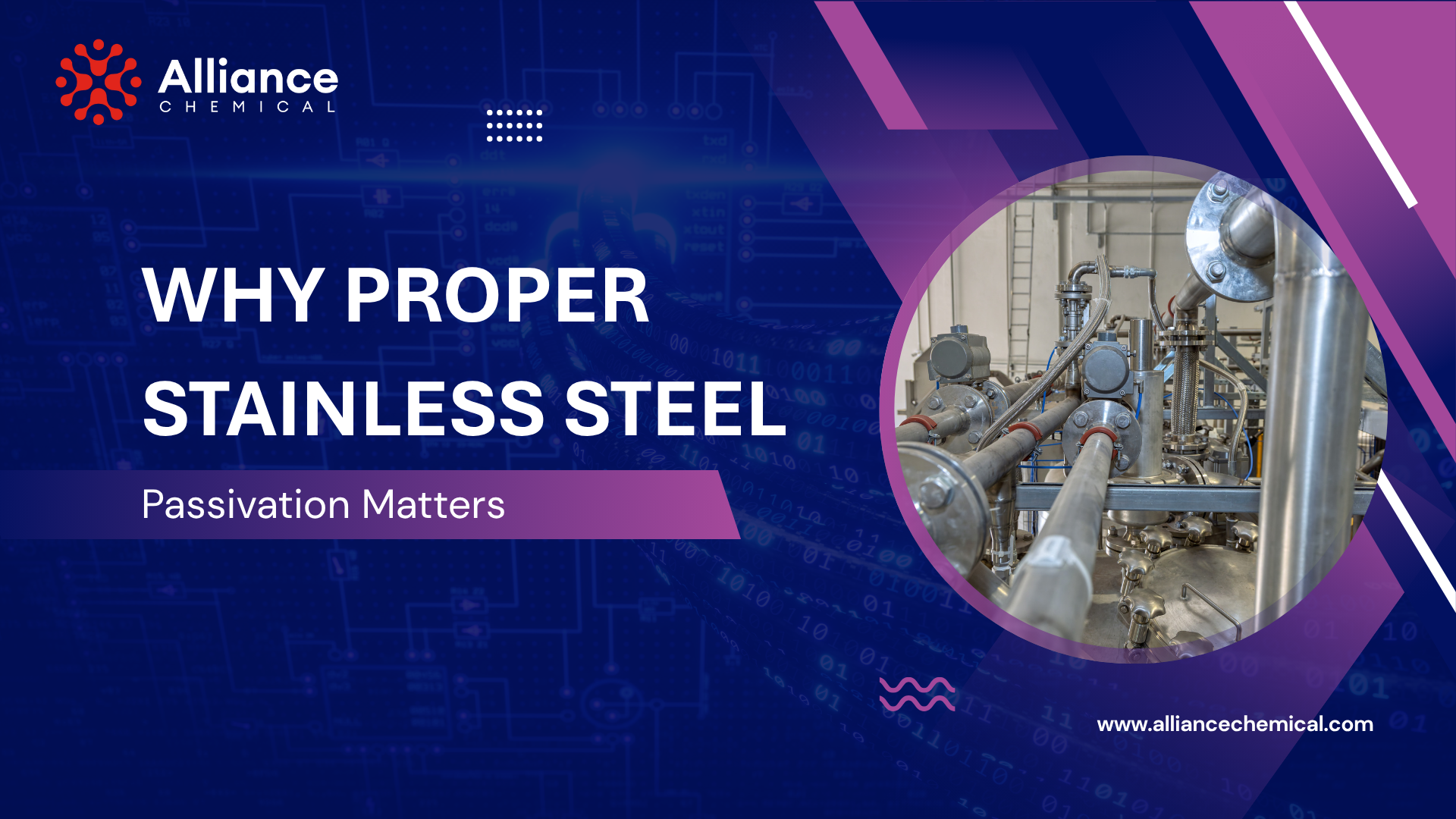
Beyond the Pungent Aroma: The Power & Precision of Ammonium Hydroxide 29% ACS Grade
Table of Contents
Summary
📋 What You'll Learn
This guide will walk you through beyond the pungent aroma: the power & precision of ammonium hydroxide 29% acs grade with detailed instructions.
Explore the multifaceted applications of high-purity Ammonium Hydroxide, from laboratory analysis and chemical synthesis to metal treatment and specialized industrial uses, with your trusted partner, Alliance Chemical.
Introduction: More Than Just "Ammonia Water" - Understanding High-Purity Ammonium Hydroxide
The sharp, unmistakable scent of ammonia is familiar to many, often associated with household cleaning solutions. However, beyond this common perception lies a highly versatile and critical chemical compound: Ammonium Hydroxide. And when specified to **29% concentration and ACS Grade purity**, it transforms into an indispensable tool for laboratories, research facilities, and a wide array of demanding industrial processes. This isn't your diluted household cleaner; it's a precisely formulated reagent engineered for performance and reliability.
At Alliance Chemical, we recognize the importance of chemical integrity. This ultimate guide is dedicated to unraveling the complexities and showcasing the power of Ammonium Hydroxide 29% ACS Grade. We'll delve into its fundamental chemistry, explain the significance of the ACS standard, and explore its pivotal roles as a laboratory reagent, a building block in chemical synthesis, a surface treatment agent in metal finishing, a key component in specialized water treatment, and its utility in industries like rubber and latex production. Join us as we go beyond the pungent aroma to reveal the precision and power of high-purity ammonium hydroxide.

Why This Guide is Essential for Professionals
For chemists, lab technicians, process engineers, and industrial buyers, understanding the nuances of Ammonium Hydroxide 29% ACS Grade ensures optimal application, safety, and product quality. This guide offers the comprehensive insights you need.
Chapter 1: Ammonium Hydroxide Decoded - Chemistry, Concentration, and the ACS Standard
To fully appreciate the applications of Ammonium Hydroxide 29% ACS Grade, a foundational understanding of its chemical nature, the significance of its concentration, and the stringent ACS (American Chemical Society) purity standards is essential.
The Chemistry: More Than Just Ammonia in Water
Ammonium Hydroxide (NH₄OH) is formed when ammonia gas (NH₃), a compound of nitrogen and hydrogen, is dissolved in water (H₂O). In solution, an equilibrium exists:
NH₃ (aq) + H₂O (l) ⇌ NH₄OH (aq) ⇌ NH₄⁺ (aq) + OH⁻ (aq)
This equilibrium shows that ammonium hydroxide is a **weak base**. It does not fully dissociate into ammonium ions (NH₄⁺) and hydroxide ions (OH⁻) like strong bases (e.g., sodium hydroxide) do. This property allows for more controlled and subtle pH adjustments in many applications. The characteristic pungent odor is due to the ammonia gas in equilibrium with the dissolved species.
The Significance of 29% Concentration (26° Baumé)
Commercial ammonium hydroxide is often supplied at a concentration of around 28-30% ammonia by weight. A common industrial designation for this is 26° Baumé (a specific gravity scale). This high concentration provides several advantages:
- Potency: It's a strong enough solution for most industrial and laboratory needs without being pure (anhydrous) ammonia, which is a gas at room temperature and requires specialized handling and storage.
- Efficiency: Less volume is needed compared to more dilute solutions for pH adjustment or reactions.
- Economic: It's a standard, cost-effective concentration for many commercial applications.
It's crucial to note that "ammonium hydroxide" is essentially a solution of ammonia in water, and the active basic component is largely the dissolved NH₃ interacting with water.
ACS Grade Purity: The Mark of Excellence
The "ACS Grade" designation signifies that the ammonium hydroxide meets the rigorous purity specifications set by the American Chemical Society for reagent chemicals. This is critical for applications where impurities could lead to erroneous analytical results, unwanted side reactions in synthesis, or contamination of high-value products. For Ammonium Hydroxide 29% ACS Grade, these specifications typically include:
- Assay (as NH₃): A minimum guaranteed percentage of ammonia, usually around 28.0-30.0%.
- Residue after Ignition: Limits non-volatile impurities (e.g., ≤0.002%).
- Carbon Dioxide (CO₂): Limits carbonate impurities which can affect pH and reactivity (e.g., ≤0.002%).
- Chloride (Cl): Controls chloride ion contamination (e.g., ≤0.00005%).
- Phosphate (PO₄): Limits phosphate impurities (e.g., ≤0.0002%).
- Sulfate (SO₄): Controls sulfate ion contamination (e.g., ≤0.0002%).
- Heavy Metals (as Pb): Limits contamination by heavy metals like lead (e.g., ≤0.00005%).
- Iron (Fe): Controls iron impurities (e.g., ≤0.00002%).
- Substances Reducing Permanganate: Indicates the presence of easily oxidizable impurities.
In contrast, Technical Grade Ammonium Hydroxide is suitable for general industrial applications where such stringent purity is not required and cost is a greater factor. The choice of grade always depends on the specific requirements of the application. Learn more about grades in our Chemical Grades Explained article.

Chapter 2: The Precision Tool - Ammonium Hydroxide 29% ACS Grade in Laboratory & Analytical Chemistry
Within the meticulous environment of the laboratory, Ammonium Hydroxide 29% ACS Grade stands as an indispensable reagent. Its defined purity, consistent strength, and well-understood chemical behavior make it a cornerstone for a multitude of analytical procedures and preparatory work. Sourcing from reliable Lab Chemical suppliers like Alliance Chemical ensures that researchers and analysts can trust the integrity of their starting materials.
pH Adjustment Perfected: The Gentle Alkalizer
One of the most frequent uses of ACS Grade Ammonium Hydroxide in the lab is for precise pH adjustment. As a weak base, it offers several advantages over strong bases like sodium hydroxide (NaOH) or potassium hydroxide (KOH):
- Finer Control: Because it doesn't fully dissociate, adding ammonium hydroxide results in a more gradual pH increase, making it easier to hit a specific target alkaline pH without overshooting. This is crucial for pH-sensitive reactions or sample preparations.
- Reduced Risk of Extreme Alkalinity: It's difficult to accidentally make a solution extremely alkaline with ammonium hydroxide, which can be a risk with strong bases.
- Volatility: In some applications, the fact that excess ammonia can be removed by gentle heating (due to its volatility) is an advantage, leaving fewer residual ions compared to non-volatile alkali metal hydroxides.
It's routinely used to adjust the pH of solutions for extractions, enzyme assays, buffer preparation, and various wet chemical analyses.
King of Qualitative Inorganic Analysis: Identifying Metal Ions
Ammonium hydroxide is a classic and vital reagent in qualitative inorganic analysis schemes, used for the separation and identification of metal cations. Its utility stems from two key properties:
-
Selective Precipitation of Metal Hydroxides: Many metal ions form insoluble hydroxides at specific pH ranges. By carefully adding ammonium hydroxide, analysts can selectively precipitate groups of metal ions. For example:
- Ions like Fe³⁺, Al³⁺, and Cr³⁺ precipitate as hydroxides in weakly ammoniacal solutions (even in the presence of ammonium chloride, which buffers the pH and prevents precipitation of some other metals).
-
Formation of Soluble Ammine Complexes: Certain metal ions, after initially precipitating as hydroxides, will redissolve in excess ammonium hydroxide due to the formation of stable, soluble metal-ammine complexes. This is a key distinguishing feature for identification:
- Copper (Cu²⁺): Forms the characteristic deep blue tetraamminecopper(II) complex, [Cu(NH₃)₄]²⁺.
- Nickel (Ni²⁺): Forms a blue hexaamminenickel(II) complex, [Ni(NH₃)₆]²⁺.
- Zinc (Zn²⁺): Forms the colorless tetraamminezinc(II) complex, [Zn(NH₃)₄]²⁺.
- Silver (Ag⁺): Forms the colorless diamminesilver(I) complex, [Ag(NH₃)₂]⁺, which is important in dissolving silver chloride precipitates.
- Cadmium (Cd²⁺): Forms a colorless tetraamminecadmium(II) complex, [Cd(NH₃)₄]²⁺.
The ACS Grade purity ensures that no interfering ions from the reagent itself complicate these delicate precipitation and complexation reactions.
Buffer Solutions – The pH Stabilizer in Alkaline Realms
Ammonium hydroxide, when combined with a salt of its conjugate acid (an ammonium salt, such as ammonium chloride, NH₄Cl), forms an effective buffer solution. This NH₃/NH₄⁺ buffer system is widely used to maintain a stable pH in the alkaline range, typically around pH 8 to 10 (its pKa is about 9.25).
- Mechanism: The buffer resists changes in pH upon addition of small amounts of acid or base. Added H⁺ ions are neutralized by NH₃, and added OH⁻ ions are neutralized by NH₄⁺.
- Applications: Essential in many biochemical assays (e.g., for enzymes that function optimally at alkaline pH), electrochemical studies, and as a component in some calibration standards and buffers.
Pristine Cleaning for Laboratory Glassware and Equipment
The cleaning power of ammonia solutions is well-known, and ACS Grade Ammonium Hydroxide provides a high-purity option for laboratory cleaning:
- Grease and Residue Removal: Effectively dissolves many organic residues, fingerprints, and light greases from glass, ceramic, and some metal surfaces.
- No-Residue Cleaning: Because both ammonia and water are volatile, a dilute solution of ammonium hydroxide can be used as a final rinse for critical glassware, as it evaporates completely, leaving no ionic or particulate residue that could contaminate future experiments. This is superior to detergents that can leave films.
In all these laboratory applications, the reliability afforded by Ammonium Hydroxide 29% ACS Grade is indispensable for achieving accurate and trustworthy scientific outcomes.
Chapter 3: Building Blocks & Catalysts - Roles in Chemical Synthesis & Pharmaceutical Manufacturing
The transition from laboratory-scale experiments to the production of fine chemicals, active pharmaceutical ingredients (APIs), and specialty materials demands chemicals of exceptional purity. Ammonium Hydroxide 29% ACS Grade plays a vital, multifaceted role in these sophisticated synthetic processes, where even trace impurities could compromise reaction yields, product purity, or safety.
A Fundamental Nitrogen Source in Organic Synthesis
Ammonia, and by extension ammonium hydroxide, serves as a primary and cost-effective source of nitrogen for incorporating nitrogen atoms into organic molecules. This is crucial for synthesizing a vast array of compounds, including:
- Amines: Primary, secondary, and tertiary amines are foundational building blocks. Ammonium hydroxide can react with alkyl halides or other electrophiles in amination reactions.
- Amides: Often formed by reacting carboxylic acids or their derivatives (like acyl chlorides or esters) with ammonia/ammonium hydroxide. Amides are prevalent in pharmaceuticals and polymers.
- Hydrazines and Derivatives: Important intermediates in pharmaceuticals and agrochemicals.
- Heterocyclic Compounds: Many nitrogen-containing heterocyclic rings, which are core structures in numerous drugs and biologically active molecules, can be synthesized using ammonia or its derivatives.
The high purity of ACS grade ensures that unwanted nitrogenous byproducts from reagent impurities are minimized.
Catalyst and pH Modifier in Key Organic Reactions
The basic nature of ammonium hydroxide allows it to function effectively as a catalyst or a critical pH modifier in various organic transformations:
-
Base Catalysis: It can catalyze reactions that proceed via deprotonation or require a basic environment, such as:
- Aldol Condensations: Formation of β-hydroxy ketones/aldehydes or α,β-unsaturated carbonyl compounds.
- Knoevenagel Condensations: Reaction of aldehydes or ketones with active methylene compounds.
- Michael Additions: Nucleophilic addition to α,β-unsaturated carbonyl compounds.
- pH Control in Reactions: Many synthetic steps are highly pH-sensitive. Ammonium hydroxide is used to precisely adjust and maintain the pH of the reaction mixture within the optimal range for desired product formation, minimizing side reactions or degradation of sensitive intermediates. This is particularly important in multi-step API synthesis where yields and purity at each stage are critical.
Crucial for Neutralization and Product Work-up in Pharmaceutical Manufacturing
After a synthetic reaction is complete, a series of work-up steps are often necessary to isolate and purify the desired product. Ammonium hydroxide plays a key role here:
- Neutralization of Acidic Byproducts or Catalysts: Many reactions generate acidic byproducts or use acidic catalysts that must be neutralized before product isolation. Ammonium hydroxide provides a controlled way to neutralize these acids.
- pH Adjustment for Extraction: The solubility of organic compounds (especially those with acidic or basic functional groups) in different solvents is often pH-dependent. Ammonium hydroxide is used to adjust the pH of aqueous layers during liquid-liquid extractions to selectively extract the product or remove impurities.
- Precipitation of Products: Sometimes, the desired product is an amine or other basic compound that can be precipitated from solution by adjusting the pH into its insolubility range using ammonium hydroxide.
In pharmaceutical manufacturing, adherence to Good Manufacturing Practices (GMP) and the use of high-purity reagents like ACS Grade Ammonium Hydroxide are essential for ensuring the safety, efficacy, and quality of the final drug product. The low levels of heavy metals and other specified impurities in ACS grade material help prevent contamination that could be detrimental to patient health or product stability.

Chapter 4: Shining & Etching - Ammonium Hydroxide in Metal Treatment & Finishing
The utility of Ammonium Hydroxide 29% ACS Grade extends significantly into the realm of metal treatment and finishing. Its ability to clean, etch, and modify pH, coupled with its high purity, makes it a valuable asset in processes where surface integrity and the absence of contaminants are crucial for achieving desired functional and aesthetic properties. Many of these applications are also covered in our comprehensive guide, The Alchemist's Toolkit.
Powerful Metal Cleaning and Degreasing Agent
Preparing a metal surface for subsequent treatments like electroplating, painting, anodizing, or welding requires it to be scrupulously clean. Ammonium hydroxide solutions are effective for:
- Removing Oils, Greases, and Shop Soils: Its alkaline nature helps to saponify (convert to soap) some fats and oils, and emulsify others, lifting them from the metal surface.
- Neutralizing Acidic Residues: Can be used as an alkaline rinse to neutralize any acidic residues from prior pickling or etching steps.
- Tarnish and Oxide Removal: Particularly effective for removing light tarnish and oxide layers from copper, brass, bronze, and silver. The ammonia forms soluble ammine complexes with these metal ions, effectively lifting the tarnish. For example, the deep blue color observed when cleaning heavily tarnished copper is due to the formation of tetraamminecopper(II) ions.
The ACS grade's low residue upon evaporation ensures that no interfering films are left behind, promoting better adhesion of subsequent coatings.
Precision Etching in Electronics: Crafting Printed Circuit Boards (PCBs)
One of the most significant industrial uses of ammonium hydroxide in metal treatment is as a key component in alkaline etchant solutions for copper in the manufacturing of Printed Circuit Boards (PCBs). This process selectively removes unwanted copper to define the conductive pathways (tracks and pads) of the circuit.
- Alkaline Etching Chemistry: Ammoniacal etchants typically contain ammonium hydroxide, an ammonium salt (like ammonium chloride or ammonium sulfate from our Sulfates or Chlorides collections), and an oxidizer (such as copper(II) ions, which are regenerated, or sometimes persulfates).
- Role of Ammonia: The ammonium hydroxide provides the alkaline pH necessary for the etching reaction and, critically, acts as a complexing agent for the dissolved copper(I) and copper(II) ions. This complexation prevents the precipitation of copper salts and allows for a high copper loading capacity in the etchant, making the process more efficient and economical.
- Selectivity: These etchants are designed to rapidly etch copper while having minimal attack on the etch resist (photomask) protecting the desired circuit pattern.
The purity of ACS Grade Ammonium Hydroxide is beneficial in these systems to maintain consistent etch rates and prevent contamination that could affect the fine-line resolution required in modern electronics.
pH Adjustment and Complexation in Electroplating Baths
As briefly touched upon in its laboratory uses, ammonium hydroxide plays a role in certain electroplating bath formulations, especially those operating at alkaline pH:
- pH Control: Maintaining the precise pH of a plating bath is critical for achieving the desired deposit properties (brightness, ductility, hardness, thickness uniformity). Ammonium hydroxide can be used for fine adjustments in alkaline baths.
-
Metal-Ammine Complexes: In some plating systems (e.g., certain types of zinc, cadmium, brass, or precious metal plating like silver or gold from cyanide-free alternatives), ammonia is intentionally added to form metal-ammine complexes. These complexes can:
- Influence the deposition potential of the metal.
- Improve the "throwing power" of the bath, which is its ability to plate uniformly onto irregularly shaped objects with recesses and high-current-density areas.
- Enhance the stability of the plating solution.
The consistency of ACS Grade Ammonium Hydroxide helps ensure stable and predictable performance of these specialized plating solutions.
Chapter 5: Specialized Industrial Applications - From Water Purity to Material Stability
Beyond the laboratory, synthesis, and direct metal treatment, Ammonium Hydroxide 29% ACS Grade finds application in several other specialized industrial sectors where its purity, concentration, and chemical properties offer distinct advantages.
Advanced Water Treatment: The Chemistry of Chloramination
While large-scale municipal water disinfection often utilizes technical grade ammonia, the chemistry of chloramination is a significant application for ammonia solutions in general, and high-purity grades can be relevant in specific, sensitive, or research-oriented water treatment scenarios.
- Chloramine Formation: Ammonium hydroxide reacts with chlorine (typically added as sodium hypochlorite or chlorine gas) to form chloramines—primarily monochloramine (NH₂Cl), and to a lesser extent dichloramine (NHCl₂) and trichloramine (NCl₃, nitrogen trichloride). The specific species formed depends on the pH, temperature, and the chlorine-to-ammonia ratio.
-
Advantages of Chloramines as Disinfectants:
- Longer-Lasting Residual: Chloramines are more stable and provide a longer-lasting disinfectant residual in water distribution systems compared to free chlorine. This helps prevent bacterial regrowth in pipes far from the treatment plant.
- Reduced Disinfection Byproducts (DBPs): Chloramination generally produces lower levels of regulated DBPs, such as trihalomethanes (THMs) and haloacetic acids (HAAs), which are potential health concerns formed when free chlorine reacts with natural organic matter in water.
- Application: The process involves careful control of dosing for both ammonia and chlorine to achieve the desired chloramine species and residual. ACS grade purity would ensure no undesirable side reactions from contaminants if used in niche, high-spec systems.
Preserving Quality: Rubber and Latex Production
Ammonium hydroxide is a crucial additive in the processing and preservation of both natural rubber latex and synthetic latex emulsions.
- Stabilizer and Preservative: Latex is a colloidal suspension of rubber particles. Without intervention, these particles can coagulate (clump together), and the latex can be susceptible to bacterial degradation.
-
Mechanism of Action: Adding ammonium hydroxide raises the pH of the latex (typically to around pH 10-11). This increase in alkalinity:
- Imparts a negative charge to the rubber particles, causing them to repel each other and preventing premature coagulation.
- Creates an environment unfavorable for the growth of bacteria and other microorganisms that can degrade the latex.
- Benefits: This stabilization allows latex to be transported, stored, and processed into various products (gloves, adhesives, coatings, foams) without significant loss of quality. The volatility of ammonia is also an advantage, as it can be easily removed during later processing stages if necessary.
Versatility in the Textile Industry
The alkaline properties of ammonium hydroxide lend themselves to several applications in textile processing:
- Scouring Natural Fibers: Used in the cleaning (scouring) of raw wool and silk to remove natural greases (lanolin in wool), sericin (in silk), dirt, and other impurities before dyeing or further processing.
- Neutralizing Agent: After acidic treatments (like some dyeing processes or carbonizing wool), ammonium hydroxide can be used to neutralize residual acidity.
- Dyeing Processes: It can act as a pH modifier or a component in certain dye formulations or after-treatment processes, particularly with some classes of dyes or for achieving specific color effects.
- Mercerization (Cotton - minor role): While strong sodium hydroxide is the primary chemical for mercerizing cotton (improving luster and strength), ammonia-based treatments have been explored for similar effects with different characteristics.
The Foundation of Modern Agriculture: Fertilizer Manufacturing Context
It's important to provide context: while ACS Grade Ammonium Hydroxide itself is not directly applied as a bulk agricultural fertilizer, the base chemical, ammonia (NH₃), is the cornerstone of virtually all synthetic nitrogen fertilizers. These fertilizers are critical for global food production.
- Haber-Bosch Process: Anhydrous ammonia is produced industrially via the Haber-Bosch process, reacting nitrogen from the air with hydrogen (typically from natural gas).
- Conversion to Fertilizers: This ammonia is then used to manufacture urea, ammonium nitrate, ammonium sulfate, ammonium phosphate, and aqua ammonia (a more dilute solution of ammonium hydroxide used for direct soil application in some regions).
Understanding this link highlights the fundamental importance of ammonia chemistry in sustaining agriculture. The image of a tractor spraying a field underscores this vital connection to food production, even if the ACS grade product has more specialized uses.

Chapter 6: A Note on Food & Beverage - Purity Parallels and Grade Distinctions
While Ammonium Hydroxide 29% ACS Grade is specifically designated and tested for laboratory and reagent uses, its base chemical (ammonia in water) shares functional similarities with "Food Grade" ammonium hydroxide used in the food and beverage industry. It is CRITICAL to understand that **only products explicitly labeled and certified as "Food Grade" (meeting FDA, FCC, or equivalent local regulations) must be used for any application involving direct or indirect food contact.** ACS Grade does not automatically imply food grade suitability, as the testing parameters and acceptable impurity profiles differ.
🛑 Critical Grade Distinction: ACS vs. Food Grade 🛑
Never use ACS Grade or Technical Grade Ammonium Hydroxide for food or beverage applications. Only use products specifically manufactured, tested, and certified as "Food Grade" from a reputable supplier who can provide appropriate documentation. Alliance Chemical may offer Food & Beverage Grade chemicals separately; always verify the grade for its intended use.
That being said, understanding the functional parallels can be illustrative of ammonia's versatility:
-
Leavening Agent Chemistry:
- In the baking industry, ammonium carbonate ((NH₄)₂CO₃) or ammonium bicarbonate (NH₄HCO₃), often referred to as "baker's ammonia" or "hartshorn," are used as leavening agents, particularly in traditional recipes for cookies, crackers, and some flatbreads.
- Upon heating during baking, these compounds decompose into ammonia gas (NH₃), carbon dioxide gas (CO₂), and water. The gases expand, creating a light, airy, and crisp texture. The pungent ammonia odor bakes off completely.
- This chemical principle is similar to how ammonium hydroxide provides ammonia for reactions, though the specific compounds and release mechanisms differ.
-
Acidity Regulation (pH Control) in Food Processing:
- Food Grade ammonium hydroxide can be used as an acidity regulator to adjust and control the pH of various food products.
- A well-known example is in the processing of cocoa to produce "Dutch-process" cocoa powder. Treating cocoa nibs with an alkaline solution (which can include ammonium hydroxide or other alkalis like potassium carbonate) neutralizes some of its natural acidity, resulting in a milder flavor, darker color, and better solubility.
- It can also be used in other products to modify tartness or stability.
The key takeaway is that while the underlying chemistry of ammonia in solution provides these functionalities, the specific grade and its associated purity profile determine its suitability for a given application. For ACS Grade, the focus is on minimal interference in precise scientific and industrial work; for Food Grade, the focus is on safety for human consumption and compliance with food processing regulations.
Chapter 7: The Unwavering Importance of Safety with 29% Ammonium Hydroxide
The effectiveness of Ammonium Hydroxide 29% ACS Grade across diverse applications stems from its chemical reactivity and concentration. These same properties necessitate unwavering attention to safety protocols. This is a corrosive and volatile substance that can cause severe harm if mishandled. A comprehensive understanding of its hazards and strict adherence to safe handling practices are paramount for anyone working with it.
🚨 HIGH HAZARD: Corrosive & Toxic Vapors! 🚨
Ammonium Hydroxide at 29% concentration is a serious chemical hazard. It can cause severe burns to skin and eyes. The pungent ammonia gas released is highly irritating and toxic to the respiratory system, potentially causing irreversible damage. Always consult the Safety Data Sheet (SDS) provided by Alliance Chemical before handling.
Essential Personal Protective Equipment (PPE):
Never handle concentrated ammonium hydroxide without appropriate, well-maintained PPE:
- Eye and Face Protection: Chemical splash goggles *and* a full-face shield are mandatory to protect against splashes and concentrated vapors. Contact lenses should not be worn.
- Hand Protection: Heavy-duty, alkali-resistant gloves are essential. Materials like butyl rubber, neoprene, or nitrile (check manufacturer's breakthrough times for concentrated ammonia) are typically recommended. Ensure gloves are long enough to cover wrists and are inspected for tears or degradation before each use.
- Body Protection: A chemical-resistant apron worn over a long-sleeved lab coat or chemical-resistant coveralls/suit is necessary to protect skin from splashes. Closed-toe shoes, preferably chemical-resistant boots, should be worn.
-
Respiratory Protection: This is CRITICAL. Due to the high volatility and toxicity of ammonia gas:
- Always work in a certified, functioning chemical fume hood or an area with demonstrably excellent local exhaust ventilation designed to capture ammonia vapors at the source.
- If ventilation is insufficient, or for spill response or specific high-exposure tasks, a NIOSH-approved respirator equipped with cartridges specifically rated for ammonia (often a magenta/olive-colored cartridge) is required. For higher concentrations or oxygen-deficient atmospheres, a self-contained breathing apparatus (SCBA) or supplied-air respirator is necessary.
- Respirator users must be properly trained, fit-tested, and part of a comprehensive respiratory protection program.

Safe Handling and Engineering Controls:
- Ventilation, Ventilation, Ventilation: Cannot be overstressed. Operations involving open containers or transfers of 29% ammonium hydroxide should always occur within a fume hood or under effective local exhaust. General room ventilation alone is usually insufficient.
-
Storage:
- Store in tightly sealed, corrosion-resistant containers (e.g., polyethylene, polypropylene, some stainless steels – check compatibility). Glass may be used for smaller lab quantities but ensure it's pressure-rated if there's any chance of pressure buildup.
- Keep in a cool, dry, well-ventilated designated chemical storage area, segregated from incompatible materials.
- CRITICAL INCOMPATIBILITIES: Store far away from ACIDS (reacts violently, generating heat and ammonia gas), HALOGENS (chlorine, bromine, iodine – can form explosive nitrogen trihalides), OXIDIZING AGENTS (bleach/sodium hypochlorite – forms toxic chloramine gas; peroxides, permanganates), and HEAVY METALS (especially mercury, silver, gold – can form explosive fulminates or azides with ammonia).
-
Handling and Dispensing:
- Dispense slowly and carefully to minimize splashing and vapor release. Use appropriate funnels or dispensing pumps.
- Work with the smallest quantity necessary for the task.
- Ensure containers are clearly and accurately labeled.
- Never work alone when handling large quantities or performing hazardous operations.
-
Emergency Preparedness:
- **Eyewash Stations and Safety Showers:** Must be immediately accessible (within 10 seconds, unobstructed path) wherever concentrated ammonium hydroxide is handled. Test regularly.
- **Spill Kits:** Have spill kits specifically designed for alkaline/ammonia spills readily available. These should include absorbents, neutralizers (e.g., citric acid, dilute acetic acid, or specialized commercial neutralizers for ammonia – *do not use strong acids*), appropriate PPE for spill response, and containment/disposal materials.
- Know emergency procedures and contact numbers.
First Aid for Ammonium Hydroxide Exposure:
(Always refer to the product-specific SDS for complete first aid instructions)
- Eye Contact: IMMEDIATELY flush eyes with copious amounts of lukewarm water for at least 15-30 minutes, holding eyelids open. Seek immediate, urgent medical attention.
- Skin Contact: IMMEDIATELY remove contaminated clothing (while under a safety shower if possible). Flush affected skin with plenty of water for at least 15-30 minutes. Seek medical attention for anything more than minor irritation, or if burns are present.
- Inhalation: IMMEDIATELY move the victim to fresh air. If breathing is difficult or has stopped, administer artificial respiration (if trained and safe to do so) and provide oxygen if available. Seek immediate, urgent medical attention.
- Ingestion: Do NOT induce vomiting. If victim is conscious and able to swallow, give small sips of water or milk. Seek immediate, urgent medical attention.
Handling Ammonium Hydroxide 29% ACS Grade safely is a non-negotiable responsibility. By understanding its hazards and rigorously applying these safety measures, its powerful chemical properties can be harnessed effectively and without incident.
Conclusion: Ammonium Hydroxide 29% ACS Grade - The Standard for Purity & Performance
From the exacting environment of the analytical laboratory to the demanding processes of industrial synthesis and specialized manufacturing, Ammonium Hydroxide 29% ACS Grade distinguishes itself as a chemical of exceptional utility and reliability. Its carefully controlled high concentration and, most importantly, its adherence to the stringent purity standards of the American Chemical Society, make it the reagent of choice where precision, consistency, and the absence of interfering contaminants are paramount.
We've journeyed through its critical roles: as a nuanced pH adjuster and selective precipitant in analytical chemistry; a foundational nitrogen source and catalyst in organic and pharmaceutical synthesis; a powerful cleaner and etchant in metal treatment; and a key player in specialized applications like water treatment and latex stabilization. In each arena, the ACS Grade specification ensures that this pungent but powerful solution performs predictably and effectively, contributing to high-quality outcomes.
However, this power demands respect. The safe handling of concentrated ammonium hydroxide, with diligent use of personal protective equipment and robust engineering controls, is an absolute imperative. At Alliance Chemical, we are committed not only to supplying superior quality Ammonia Products, including ACS Grade Ammonium Hydroxide, but also to providing the information necessary for their safe and effective use.
Whether you are a researcher seeking reproducible analytical results, an engineer optimizing a manufacturing process, or a technician ensuring the quality of finished goods, choosing high-purity Ammonium Hydroxide 29% ACS Grade is an investment in the integrity and success of your work.
Ammonium Hydroxide 29% ACS Grade
Meets rigorous ACS specifications for purity. Ideal for laboratory analysis, chemical synthesis, and critical industrial applications. Various sizes available.
View ACS GradeAmmonium Hydroxide 29% Technical Grade
A cost-effective, concentrated solution for general industrial cleaning, pH adjustment, and applications where ACS purity is not mandated.
View Technical GradeBases & Caustics Collection
Explore our full range of high-quality bases, alkalis, and caustic solutions for all your laboratory and industrial requirements.
Browse BasesHarness the Power of Pure Ammonium Hydroxide
For applications demanding precision and reliability, choose Alliance Chemical's Ammonium Hydroxide 29% ACS Grade. Our commitment to quality ensures you get the performance your critical work deserves. Contact our experts for bulk inquiries or technical support.
Shop ACS NH₄OH Contact Our Team








